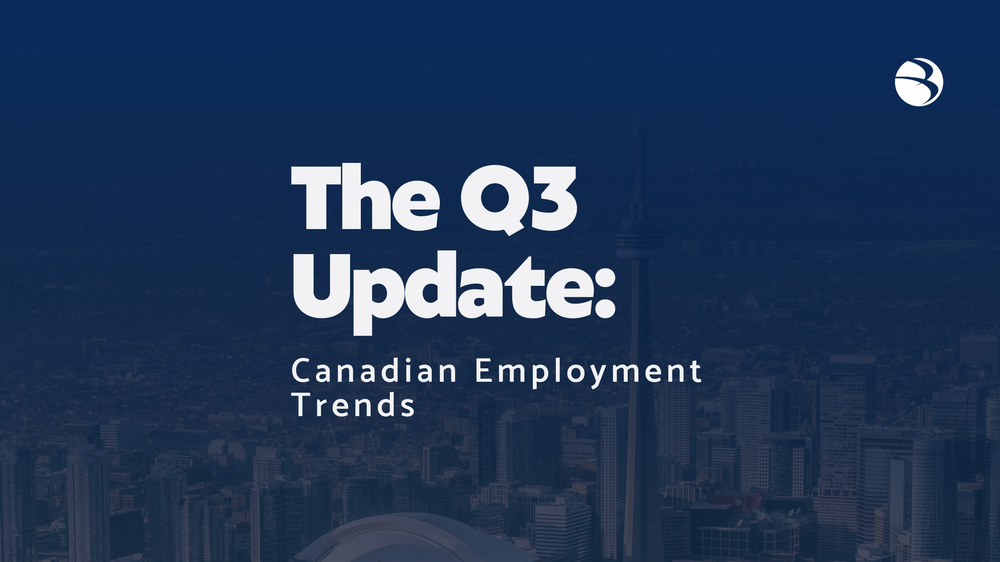The Q3 Update: Canadian Employment Trends

In September 2023, Canada saw a surge in employment, with a total of 20,270,000 individuals gaining employment. Since the beginning of January 2023, employment has been growing at an average rate of 25,000 per month.
The increase in employment during September was primarily focused on part-time positions, experiencing a gain of 48,000 positions, representing a 1.3% increase. Year-to-date data reveals that the growth in part-time employment, which stands at 1.9%, has exceeded the growth in fulltime employment, which is at 1.0%.
The unemployment rate held steady at 5.5% for the third consecutive month.
During September, there was a 0.1 percentage point increase in the employment rate, bringing it to 62.0%. This increase effectively countered the decrease observed in August. The employment rate for September remained relatively stable compared to the same month in 2022, at 61.9%, although it declined by 0.5 percentage points from the peak reached in January 2023, which was 62.5%.
Employment Gains by Industry
In September, there was a notable uptick in employment within the educational services sector, with a significant increase of 66,000 jobs, representing a growth of 4.5%. This effectively countered the decrease of 44,000 jobs, a 2.9% decline observed in August. It's worth noting that slight variations in the timing of school-year contracts coming to an end and commencing can influence the month-to-month changes in seasonally adjusted employment figures for this industry, particularly over the summer months.
Over the period from May to September, employment within the education services sector saw a gradual increase of 26,000 jobs, reflecting a 1.8% rise and continuing a positive trend that began in September 2022.
The transportation and warehousing, employment witnessed an increase of 19,000 positions, equivalent to a 1.8% growth in September, following a gain of 13,000 jobs in August 2023.
Since January, the total workforce engaged in transportation and warehousing has expanded by 82,000 individuals. This increase accounted for more than one-third, specifically 34.4%, of the net employment growth seen across all industries during this period.
Meanwhile, employment in the health care and social assistance sector remained relatively stable in September. Although year-over-year employment experienced a 2.5% rise, equivalent to 66,000 jobs, this growth aligned with the average pace observed across all industries throughout the year, which stood at 2.8%.
Growth Led by Provinces and Territories
In Quebec, there was a notable employment upswing in September, with an increase of 39,000 jobs, marking a 0.9% growth. This follows a period of relative stability in the previous seven months. The unemployment rate held steady at 4.4%, showing minimal change compared to the prior month. The employment growth, surpassing the growth rate in the working-age population, led to a 0.4 percentage point increase in the employment rate, reaching 62.3% for September.
British Columbia also experienced a boost in employment, with an increase of 26,000 jobs, representing a 0.9% rise. This marks the second consecutive monthly gain for the province. The unemployment rate remained largely unchanged at 5.4% in September compared to August, while the employment rate rose by 0.4 percentage points, reaching 61.9%.
In September, there were employment increases in Manitoba with 8,800 jobs, Saskatchewan with 6,000 job, Nova Scotia with 3,200 jobs, and Prince Edward Island with 2,700 jobs.
During the third quarter, there were minimal alterations in the employment rates for Yukon and Nunavut, with rates standing at 70.5% and 55.3%, respectively, remaining relatively stable compared to the preceding quarter. However, the employment rate in the Northwest Territories experienced a decline of 1.3 percentage points, falling to 69.2% from the second to the third quarter.
It's noteworthy that in September, due to severe wildfires, Yellowknife and various other communities in the Northwest Territories had to be evacuated.
Compensation Trends
Average Salary Increase Forecasts: The average salary increase forecast for 2024 in Canada is 3.6%, excluding salary freezes. This figure represents a slight softening compared to the previous year. However, it remains higher than what is considered normal.
Actual Salary Increases in 2023: In 2023, organizations in Canada granted an average salary increase of 4.1%, which exceeded the initial projections of 3.8% and 4.2% published in February 2022 and July 2023, respectively. This indicates that companies adapted to market pressures by providing higher increases than initially expected.
Compensation Cost Containment: More than half of organizations in Canada do not have compensation cost containment measures in place to manage a possible economic slowdown. This is largely due to ongoing labor shortages, which have put upward pressure on wages.
Variation Across Company Ownership Types (2024 Forecast):
- Private sector (not listed on the stock market): 3.6%
- Not-for-profit organizations: 3.6%
- Private sector (listed on the stock market): 3.5%
- Public and parapublic sectors: 3.3%
Sectors Setting the Pace (2024 Forecast)
Certain sectors in Canada are projected to offer salary increases above the national average of 3.6% for 2024:
- Professional, scientific and technical services: 3.9%
- Real estate, rental, and leasing: 3.9%
- High technology: 3.9%
- Pharmaceutical and biotechnology: 3.8%
- Durable goods manufacturing: 3.8%
- Accommodation and food services: 3.7%
These trends reflect the ongoing adjustments in compensation practices in Canada, influenced by market conditions, labor shortages, and the cautious approach to salary freezes. Organizations are continuing to adapt to economic fluctuations and competitive pressures, with variations across sectors and ownership types in their salary increase forecasts for 2024.
The data provided is credited to Normandin Beaudry, a reputable source for compensation and benefits information in Canada.
At Bevertec, our dedication revolves around uniting outstanding professionals with employers, a crucial element in nurturing a positive shift within the Canadian employment landscape. We are motivated to bridge gaps and harmonize highly skilled individuals with visionary enterprises, igniting advancement and creativity in the constantly changing job sector.




